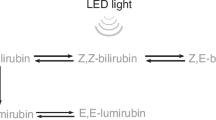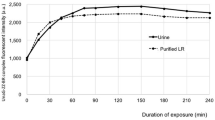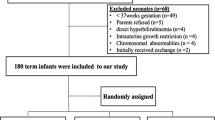Abstract
Background:
In neonatal jaundice, phototherapy converts bilirubin to more polar photoisomers which can be excreted without conjugation. We measured changes in the concentration of bilirubin Z,E-photoisomer during the first 4 h of intensive phototherapy using single fluorescent lights as a reference, compared to double fluorescent lights, and a single unit of photodiodes.
Methods:
Neonates (N = 42; birth weight: 1,200–4,690 g; gestational age: 28–42 wk) were studied during phototherapy. Infants were randomized to: (i) single, or (ii) double fluorescent phototherapy; or (iii) single unit photodiodes. Irradiance was measured. Serum bilirubin (by cooximetry) and Z,E bilirubin (by high-pressure liquid chromatography) were measured at 0,15, 30, 60, 120, and 240 min after the start of phototherapy. Data were analyzed with a linear mixed model.
Results:
There was a highly significant increase of Z,E-bilirubin over time (P < 0.0001), starting at 15 min. Photoisomers reached ~25% of total bilirubin concentration after 4 h. However, there were no significant differences between the three randomized groups in spite of significantly higher irradiance using double fluorescent lights vs. single fluorescent or photodiodes.
Conclusion:
Formation of bilirubin photoisomers is rapid, and occurs early during intensive phototherapy for neonatal jaundice. The rate and level of photoisomerization was not influenced by irradiance and light source.
Similar content being viewed by others
Log in or create a free account to read this content
Gain free access to this article, as well as selected content from this journal and more on nature.com
or
References
Hansen TW. Phototherapy for neonatal jaundice--therapeutic effects on more than one level? Semin Perinatol 2010;34:231–4.
Tyson JE, Pedroza C, Langer J, et al.; Eunice Kennedy Shriver National Institute of Child Health and Human Development Neonatal Research Network. Does aggressive phototherapy increase mortality while decreasing profound impairment among the smallest and sickest newborns? J Perinatol 2012;32:677–84.
Maisels MJ, McDonagh AF. Phototherapy for neonatal jaundice. N Engl J Med 2008;358:920–8.
McDonagh AF, Lightner DA. Phototherapy and the photobiology of bilirubin. Semin Liver Dis 1988;8:272–83.
McDonagh AF, Palma LA, Trull FR and Lightner DA. Phototherapy for neonatal jaundice. Configurational isomers of bilirubin. J Am Chem Soc 1982;104:6865–7.
McDonagh AF, Palma LA and Lightner DA. Phototherapy for neonatal jaundice. Stereospecific and regioselective photoisomerization of bilirubin bound to human serum albumin and NMR characterization of intramolecularly cyclized photoproducts. J Am Chem Soc 1982;104:6867–8.
McDonagh AF. Controversies in bilirubin biochemistry and their clinical relevance. Semin Fetal Neonatal Med 2010;15:141–7.
Myara A, Sender A, Valette V, et al. Early changes in cutaneous bilirubin and serum bilirubin isomers during intensive phototherapy of jaundiced neonates with blue and green light. Biol Neonate 1997;71:75–82.
Ebbesen F, Madsen P, Støvring S, Hundborg H, Agati G. Therapeutic effect of turquoise versus blue light with equal irradiance in preterm infants with jaundice. Acta Paediatr 2007;96:837–41.
Mreihil K, McDonagh AF, Nakstad B, Hansen TW. Early isomerization of bilirubin in phototherapy of neonatal jaundice. Pediatr Res 2010;67:656–9.
Ennever JF, Sobel M, McDonagh AF, Speck WT. Phototherapy for neonatal jaundice: in vitro comparison of light sources. Pediatr Res 1984;18:667–70.
Costarino AT Jr, Ennever JF, Baumgart S, Speck WT, Polin RA. Effect of spectral distribution on isomerization of bilirubin in vivo. J Pediatr 1985;107:125–8.
Okada H, Abe T, Etoh Y, et al. In vitro production of bilirubin photoisomers by light irradiation using neoBLUE. Pediatr Int 2007;49:318–21.
Maisels MJ. Phototherapy--traditional and nontraditional. J Perinatol 2001;21:Suppl 1:S93–97; discussion S104–107.
Vreman HJ, Wong RJ, Murdock JR, Stevenson DK. Standardized bench method for evaluating the efficacy of phototherapy devices. Acta Paediatr 2008;97:308–16.
American Academy of Pediatrics Subcomittee on Hyperbilirubinemia. Management of hyperbilirubinemia in the newborn infant 35 or more weeks of gestation. Pediatrics 2004;114:297–316.
Donneborg ML, Knudsen KB, Ebbesen F. Effect of infants’ position on serum bilirubin level during conventional phototherapy. Acta Paediatr 2010;99:1131–4.
McDonagh AF, Lightner DA. ‘Like a shrivelled blood orange’–bilirubin, jaundice, and phototherapy. Pediatrics 1985;75:443–55.
Johnson L, Bhutani VK, Karp K, Sivieri EM, Shapiro SM. Clinical report from the pilot USA Kernicterus Registry (1992 to 2004). J Perinatol 2009:29:Suppl 1:S25–45.
Harris MC, Bernbaum JC, Polin JR, Zimmerman R, Polin RA. Developmental follow-up of breastfed term and near-term infants with marked hyperbilirubinemia. Pediatrics 2001;107:1075–80.
Hansen TW, Nietsch L, Norman E, et al. Reversibility of acute intermediate phase bilirubin encephalopathy. Acta Paediatr 2009;98:1689–94.
Lamola AA, Blumberg WE, McClead R, Fanaroff A. Photoisomerized bilirubin in blood from infants receiving phototherapy. Proc Natl Acad Sci USA 1981;78:1882–6.
Onishi S, Isobe K, Itoh S, Kawade N, Sugiyama S. Demonstration of a geometric isomer of bilirubin-IX alpha in the serum of a hyperbilirubinaemic newborn infant and the mechanism of jaundice phototherapy. Biochem J 1980;190:533–6.
Onishi S, Isobe K, Itoh S, et al. Metabolism of bilirubin and its photoisomers in newborn infants during phototherapy. J Biochem 1986;100:789–95.
Costarino AT, Ennever JF, Baumgart S, Speck WT, Paul M, Polin RA. Bilirubin photoisomerization in premature neonates under low- and high-dose phototherapy. Pediatrics 1985;75:519–22.
Lamola AA, Bhutani VK, Wong RJ, Stevenson DK, McDonagh AF. The effect of hematocrit on the efficacy of phototherapy for neonatal jaundice. Pediatr Res 2013;74:54–60.
Bratlid D, Nakstad B, Hansen TW. National guidelines for treatment of jaundice in the newborn. Acta Paediatr 2011;100:499–505.
Djokomuljanto S, Quah BS, Surini Y, et al. Efficacy of phototherapy for neonatal jaundice is increased by the use of low-cost white reflecting curtains. Arch Dis Child Fetal Neonatal Ed 2006;91:F439–42.
Itoh S, Isobe K, Onishi S. Accurate and sensitive high-performance liquid chromatographic method for geometrical and structural photoisomers of bilirubin IX alpha using the relative molar absorptivity values. J Chromatogr A 1999;848:169–77.
Acknowledgements
We thank Angelo Lamola, PhD, for helpful discussions on the analysis of the Hb data. We thank nurses at the NICU at Akershus University Hospital for good collaboration
Author information
Authors and Affiliations
Corresponding author
PowerPoint slides
Rights and permissions
About this article
Cite this article
Mreihil, K., Madsen, P., Nakstad, B. et al. Early formation of bilirubin isomers during phototherapy for neonatal jaundice: effects of single vs. double fluorescent lamps vs. photodiodes. Pediatr Res 78, 56–62 (2015). https://doi.org/10.1038/pr.2015.61
Received:
Accepted:
Published:
Issue date:
DOI: https://doi.org/10.1038/pr.2015.61
This article is cited by
-
Sixty years of phototherapy for neonatal jaundice – from serendipitous observation to standardized treatment and rescue for millions
Journal of Perinatology (2020)
-
Double versus single intensive phototherapy with LEDs in treatment of neonatal hyperbilirubinemia
Journal of Perinatology (2018)
-
The impact of hemoglobin on the efficacy of phototherapy in hyperbilirubinemic infants
Pediatric Research (2017)
-
Spectral Range Optimization to Enhance the Effectiveness of Phototherapy for Neonatal Hyperbilirubinemia
Journal of Applied Spectroscopy (2017)
-
Bilirubin isomer distribution in jaundiced neonates during phototherapy with LED light centered at 497 nm (turquoise) vs. 459 nm (blue)
Pediatric Research (2016)



